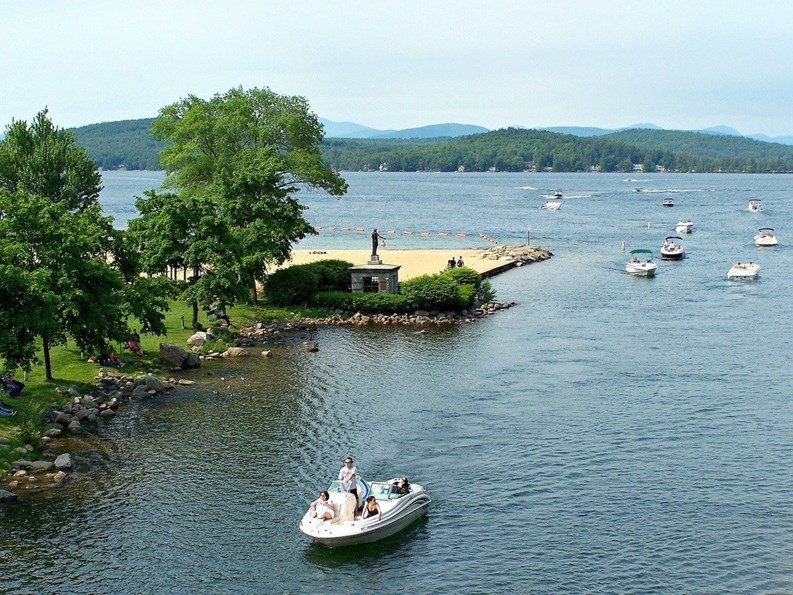Just south of the White Mountains in New Hampshire, one will find the city of Laconia, a popular resort town known in the winter for its skiing, snow tubing and ziplining and in the summer for its extensive beachfront, teeming rivers and crystal clear lakes.
A county seat of Belknap County, the population grew from around 1,800 in 1860 to about 16,000 by the 2010 census.
Early History
Laconia, the City on the Lakes, originated from a large Abenaki Indian settlement called Acquadocton Village. This village, at the point known as The Weirs, referred to the fishing weirs discovered by colonists at the outlet of the Winnipesaukee River.
These early explorers hoped to follow the rivers in the area north to Lake Champlain, as they were searching for the great Canadian rivers and lakes they had heard mentioned in Indian folklore. A local landmark, Endicott Rock, even commemorates the visit in 1652 of a surveying party commissioned by Massachusetts colonial governor John Endicott to find the boundary line between Massachusetts and New Hampshire at the headwaters of the Merrimack River. This historic site is the oldest public monument in New England. A fort would be built at Laconia in 1746 but the ongoing hostilities in the area caused by the French and Indian War prevented permanent settlement. Europeans finally settled there in 1761, after which it remained for many years a part of Meredith and Gilford called Meredith Bridge. The settlement was self-sufficient and starting in 1765, lumber, wheat, corn and grist mills were established on Mill Street, with taverns built soon thereafter on Parade Street. Manufacturing came along and about 1822, the courthouse was built, which would become county seat at the creation of Belknap County in 1840.
One of the local attractions is the Belknap Mill, built in 1832 to manufacture textiles and other products. Today the structure—the oldest unaltered brick textile mill in the country—is a museum listed on the National Register of Historic Places.
Throughout the second half of the 19th century, Laconia grew into an industrial center with the production of lumber, textiles, shoes, hosiery, knitting machinery and needles. Tourism also flourished and immigrants from Canada provided ready labor. The emergence of the railroads and steamship lines brought an influx of lodging, boarding houses and large hotels. Transportation needs within the city for tourists and residents alike were met by trolley cars and the Ranlet Car Company, at first a builder of railcars, which played an important role in the city’s development. The car company became the city’s largest employer, expanding to the building of trolley and subway cars. The Laconia Car Company operated from 1848 through the 1930s. The railroad popularized the area, bringing summer tourists to Weirs Beach.
The Great Fire
In 1855, Laconia was incorporated as a town from land in Meredith Bridge, Lakeport, Weirs and part of Gilmanton. The name was probably derived from the old Laconia Company, formed by Captain John Mason and the Masonian proprietors to sell parcels of land during colonial times. The Great Fire of 1860 destroyed most of Main Street from Mill to Water streets, followed by the Great Lakeport Fire of 1903, a blaze so fierce that fire companies were brought by train from as far away as Dover. Laconia officially became a city in 1893.
Manufacturing continued until the late 1960s in Laconia, when its downtown was revitalized, leading to a spurt of new development. Now the region has light manufacturing and tech industries, as well as a solid base of professionals and service industries. Tourism still remains integral to Laconia during all four seasons of the year.
According to the United States Census Bureau, the city has a total area of 26.6 square miles; it is bounded in the southwest by Winnisquam Lake and by Lake Winnipesaukee in the northeast. As of the census of 2000, there were 16,411 people, 6,724 households, and 4,168 families residing in the city.
Today, Laconia is governed by a mayor-council and city manager system. The mayor and council are elected in a citywide vote, while the city manager is hired by the council. The council consists of six members, who are elected from the six single-member wards.
Bikers, Winter and Water Sports
The Lakes Region of New Hampshire has been delighting visitors for generations. Dotted with two hundred and fifty-three islands and at seventy-two square miles in size, Lake Winnipesaukee is the centerpiece of the region’s natural beauty and its endless activities.
If winter sports are your fancy, you’re in luck. At nearby Gunstock Mountain in Gilford, you’ll find the third largest family ski area in the Granite State. There you can hit the powder, snow tube, snowboard, swim, camp or if you are more adventurous, take a breathtaking zipline ride past the mountain peaks for spectacular views of Lake Winnipesaukee, Weirs Beach and the entire valley below. Gunstock gets an average of around 120 inches of snow each year.
And you can go hog-wild if you’re a biker. Laconia Motorcycle Week is an annual motorcycle rally that brings thousands of riders to the Weirs Beach region every June. It began in 1916 when a few hundred bikers gathered at Weirs Beach and it grew in popularity into a nine-day event that ends on Father’s Day. It is the oldest national bike rally in the U.S. The event has had its ups and downs, enduring a riot that made national news in 1965 to a more calming presence today.
So if you’re looking for a year-round vacation spot or a simple place to settle down in front of a nice cozy fire on a chilly winter’s night, Laconia might just fit the bill.
Debra A. Estock is executive editor of New England Condominium.




Leave a Comment